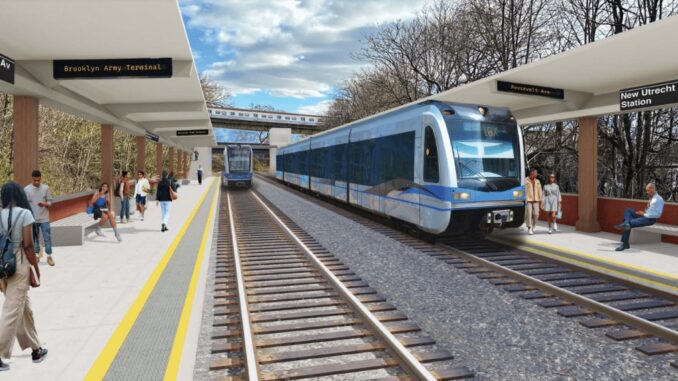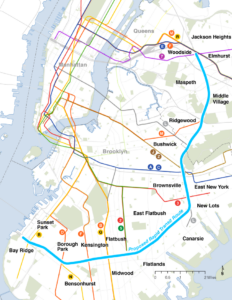
By Kate Dempsey
The 14-mile light rail train line connecting Brooklyn to Queens, known as the Interborough Express Project (IBX), is now officially underway, according to the Metropolitan Transportation Authority (MTA). In a press conference held on Oct. 29 at a future IBX station, the MTA announced that preliminary work, including engineering proposals and design, has begun, according to Bloomberg.
City officials have stated that the intended project is to help Brooklyn and Queens residents have greater access to these boroughs without having to commute via Manhattan, a change that could allow for faster commutes and accessibility. When implemented, it would include 19 stations in total and allow transfers to the N, R, D, B, Q, 2, 5, L, 3, J, Z, A, C, M, 7, E, and F trains, according to MTA’s plan. This is in addition to helping get rid of the “transit deserts” located in East Flatbush, East New York, and parts of western Queens.
“We’re turning it into something which is transformative for so many New Yorkers,” MTA chair and CEO Janno Lieber said, according to Bloomberg. “It makes no sense that the 5 million people who live in Brooklyn and Queens have to go to Manhattan on the subway to reach the other borough.”
Light rail, as opposed to traditional subway trains, will be able to operate both on traditional train tracks and on city streets with train cars that are smaller than the average subway car. According to the MTA’s plan outlined in Crain’s New York, light rail cars have greater speed and lower production cost, making them more cost efficient. Reducing costs is of the utmost importance to city leaders, as only $2.7 billion of the $5.5 billion needed to complete the project has been raised; $134 million has been allocated for the preliminary work from grants and the state budget, according to NY1.
“First, [the preliminary work] will get us all the way through the federal environmental review that’s necessary to advance the project. Second, it will give us what we need to compete for federal funding that’s critical to getting the project built,” Jamie Torres-Springer, president of MTA Construction and Development, told NY1. “And third, it gets us to the next step. The next step is having a builder get started on delivering the IBX.”
Concerns over funding have grown since the pause in congestion pricing, which would have been used to fund the project. As previously reported by The Vanguard, congestion pricing saw increased fares for passenger cars, trucks, and more traveling between the hours of 9 a.m. to 5 p.m. into and out of Manhattan. In order to meet the project’s funding needs, new measures will have to be taken. Governor Kathy Hocul, a proponent of the IBX’s completion, has stated she will fight to secure funding on state and local levels.

“We will review the MTA’s proposal for the upcoming five-year capital plan and fight to secure as much funding as possible,” Hochul said in a statement on Sept. 18 according to ABC7. “That includes pressuring Washington to deliver additional infrastructure dollars and working with our partners in the Legislature and City Hall to determine priorities and capacity during the upcoming budget negotiations.”
The Flatbush Nostrand Junction Business Improvement District (BID), which advocates for economic growth and development in the greater area surrounding Brooklyn College, sees the IBX project as a beneficial addition to the area, creating greater accessibility and bringing in more consumers.
“By connecting these boroughs, the IBX will make the Junction—a thriving hub of both small and large businesses—even more accessible,” Kenneth Mbonu, president and executive director of Flatbush Nostrand Junction BID, told The Vanguard. “Additionally, the increased connectivity will draw professional service companies to the area, boosting economic opportunities and enhancing the Junction’s role as a dynamic commercial and educational center.”
In addition, students who may have previously had limited access reaching BC will now have another reliable means of reaching the campus; the IBX has the potential to open BC to other student populations who may not have been able to reach the campus before. To BC educators and administration, funding the IBX means funding public education.
“When this project is complete, it will make commuting to Brooklyn College from many places across the city so much easier,” BC president Michelle J. Anderson told The Vanguard. “Funding and supporting all aspects of public education should always be a priority, and that includes safe and reliable transportation.”
Though a project timeline has yet to be released, it is estimated to take three to five years to complete, according to MTA’s plan. As for next steps, the MTA plans to continue its environmental review in the coming months, conducting an in-depth evaluation of its design as well as seeking public comment on its construction.
This is a developing story. The Vanguard will release updates as they are made available.
